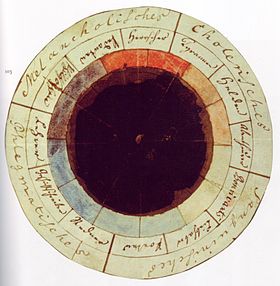
Back علم نفس الألوان Arabic Psicología del color Catalan Psychologie barev Czech Psicología del color Spanish Kolorearen psikologia Basque روانشناسی رنگها Persian Psychologie des couleurs French Psicoloxía da cor Galician रंग मनोविज्ञान Hindi Գույնի ընկալման հոգեբանություն Armenian

Color psychology is the study of hues as a determinant of human behavior. Color influences perceptions that are not obvious, such as the taste of food. Colors have qualities that can cause certain emotions in people.[1] How color influences individuals may differ depending on age, gender, and culture.[2] Although color associations can vary contextually between cultures, color preference is thought to be relatively uniform across gender and race.[3]
Color psychology is also widely used in marketing and branding. Marketers see color as an important factor, since color can influence a consumers' emotions and perceptions about goods and services.[4] Logos for companies are important, since the logos can attract more customers.[5]
The field of color psychology applies to many other domains such as medical therapy, sports, hospital settings, and even in game design. Carl Jung has been credited as one of the pioneers in this field for his research on the properties and meanings of color in our lives. According to Jung, "colours are the mother tongue of the subconscious."[4]
Before there was color psychology as a field, color was being used for centuries as a method of treatment as early as 2000 BC. The ancient Egyptians documented color "cures" using painted rooms or sunlight shining through crystals as therapy. One of the earliest medical documents, the Huangdi Neolignane Ching, documents color diagnoses associated with color healing practices.[6]
In 1810, German poet Johann Wolfgang von Goethe published Theory of Colors, a book explaining his beliefs on the psychological nature of color.[7] In his book, von Goethe describes the color yellow as "serene" and blue as a mixture of "excitement and repose."[8] In 1942, Kurt Goldstein, a German neurologist, conducted a series of experiments on various participants to determine the effects of color on motor function. In one experiment, Goldstein claims that a woman suffering from a cerebral disease was prone to frequently falling over and wearing red significantly increased this. However, wearing the colors green or blue calmed these symptoms.[9] Other researchers were unable to prove Goldstein's studies to be true, therefore, his hypothesis is considered inaccurate.[10] While Goldstein's hypothesis was never proven, his work encouraged further research into the physiological effects of color.[10]
Carl Jung is most prominently associated with the pioneering stages of color psychology in the 20th century. Jung was most interested in colors' properties and meanings, as well as in art's potential as a tool for psychotherapy. His studies in and writings on color symbolism cover a broad range of topics, from mandalas to the works of Picasso to the near-universal sovereignty of the color gold, the lattermost of which, according to Charles A. Riley II, "expresses... the apex of spirituality, and intuition".[11] In pursuing his studies of color usage and effects across cultures and time periods, as well as in examining his patients' self-created mandalas, Jung attempted to unlock and develop a language, or code, the ciphers of which would be colors. He looked to alchemy to further his understanding of the secret language of color, finding the key to his research in alchemical transmutation. His work has historically informed the modern field of color psychology.
- ^ Roohi S, Forouzandeh A (May 2019). "Regarding color psychology principles in adventure games to enhance the sense of immersion". Entertainment Computing. 30: 100298. doi:10.1016/j.entcom.2019.100298. ISSN 1875-9521. S2CID 133023544.
- ^ Kurt, Sevinc; Osueke, Kelechi Kingsley (2014-01-01). "The Effects of Color on the Moods of College Students". SAGE Open. 4 (1): 215824401452542. doi:10.1177/2158244014525423. ISSN 2158-2440.
- ^ Birren F (1961). Colour Psychology & Colour Therapy. Secaucus, NJ: The Citadel Press. p. 198. ISBN 0806506539.
- ^ a b "Character Costume Design Creation", Character Costume Figure Drawing, Routledge, pp. 169–183, 2013-03-20, doi:10.4324/9780080954073-12, ISBN 978-0-08-095407-3, retrieved 2022-05-04
- ^ Findlay P (2018-09-12). "The ketchup and mustard theory of advertising, AKA learning to taste your brand". Mumbrella. Retrieved 2021-09-08.
- ^ "Color History". Colour Therapy Healing. 2016-04-01. Retrieved 2021-11-20.
- ^ Popova, Maria (2012-08-17). "Goethe on the Psychology of Color and Emotion". The Marginalia. Retrieved 2023-02-12.
- ^ von Goethe, Johann Wolfgang (2014-10-02). Goethe's Theory of Colors. Cambridge University Press. doi:10.1017/cbo9781107589438. ISBN 978-1-108-07544-2.
- ^ Goldstein, Kurt (June 1942). "Some Experimental Observations Concerning the Influence of Colors on the Function of the Organism". American Journal of Physical Medicine & Rehabilitation. 1 (1): 147–151. doi:10.1097/00002060-194206000-00002. ISSN 0894-9115. S2CID 84919425.
- ^ a b "Color Psychology". Nikolaev. Retrieved 2023-02-12.
- ^ Riley, Charles A. II. Color Codes: Modern Theories of Color in Philosophy, Painting and Architecture, Literature, Music, and Psychology. Hanover: University Press of New England, 1995, p. 307.
© MMXXIII Rich X Search. We shall prevail. All rights reserved. Rich X Search